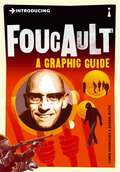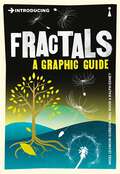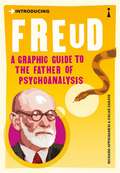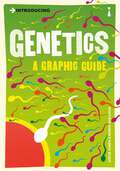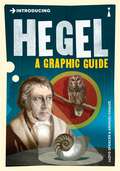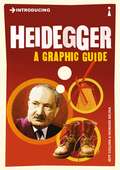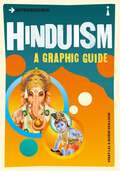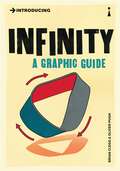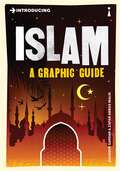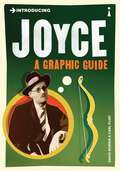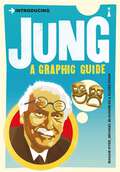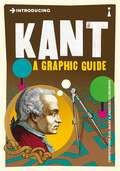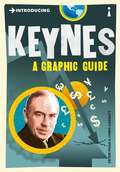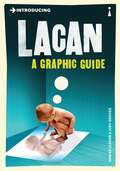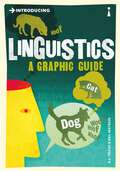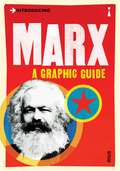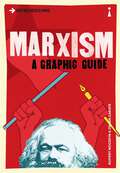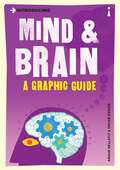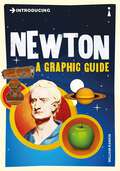- Table View
- List View
Introducing Foucault: A Graphic Guide (Introducing...)
by Chris HorrocksMichel Foucault's work was described at his death as 'the most important event of thought in our century'. As a philosopher, historian and political activist, he certainly left behind an enduring and influential body of work, but is this acclaim justified? "Introducing Foucault" places his work in its turbulent philosophical and political context, and critically explores his mission to expose the links between knowledge and power in the human sciences, their discourses and institutions. This book explains how Foucault overturned our assumptions about the experience and perception of madness, sexuality and criminality, and the often brutal social practices of confinement, confession and discipline. It also describes Foucault's engagement with psychiatry and clinical medicine, his political activism and the transgressive aspects of pleasure and desire that he promoted in his writing.
Introducing Fractals: A Graphic Guide (Introducing...)
by Nigel Lesmoir-Gordon Will RoodFractals are the geometry of the natural world. They're about the broken, wrinkled, wiggly world- the uneven shapes of nature, unlike the idealised forms of Euclidean geometry. We see fractals everywhere; indeed, we are fractals ourselves. Fractal geometry is an extension of classical geometry which can make precise models of physical structures, from ferns to galaxies. It can describe the shape of a cloud as precisely as an architect can describe a house. Introducing Fractals traces the historical development of this mathematical discipline, explores its descriptive powers in the natural world, and then looks at the applications and the implications of the discoveries it has made. As John Archibald Wheeler, protégé of Niels Bohr, friend of Albert Einstein and mentor of Richard Feynman has said, 'No one will be considered scientifically literate tomorrow, who is not familiar with fractals.'
Introducing Freud: A Graphic Guide (Introducing...)
by Richard Appignanesi Oscar ZarateFreud revolutionized the way we think about ourselves. His psychoanalytic terms such as Id, Ego, libido, neurosis and Oedipus Complex have become a part of our everyday vocabulary. But do we know what they really mean? Introducing Freud successfully demystifies the facts of Freud's discovery of psychoanalysis. Irreverent and witty but never trivial, the book tells the story of Freud's life and ideas from his upbringing in 19th-century Vienna, his early medical career and his encounter with cocaine, to the gradual evolution of his theories on the unconscious, dreams and sexuality. With its combination of brilliantly clever artwork and incisive text, this book has achieved international success as one of the most entertaining and informative introductions to the father of psychoanalysis.
Introducing Genetics: A Graphic Guide (Introducing...)
by Steve Jones"Introducing Genetics" takes readers on a journey through this new science to the discovery of DNA and the heart of the human gene map. In everyday life, many of us increasingly have to make moral decisions where genetics plays a part. This book gives us the information to do so.
Introducing Hegel: A Graphic Guide (Introducing...)
by Lloyd SpencerINTRODUCING guide to the hugely influential German thinker. Georg Wilhelm Friedrich Hegel is one of the greatest thinkers of all time. No other philosopher has had such a profound impact on the ideas and political events of the 20th century. Hegel's influential writings on philosophy, politics, history and art are parts of a larger systematic whole. They are also among the most difficult in the entire literature of philosophy. Introducing Hegel guides us through a spectacular system of thought which aimed to make sense of history. The book also provides new perspectives on contemporary postmodern debates about 'metanarratives' (Lyotard) and the 'end of history' (Fukuyama). It is an ideal introduction to this crucial figure in the history of philosophy, and is indispensable for anyone trying to understand such key modern thinkers as Marx, Lacan, Satre and Adorno.
Introducing Heidegger: A Graphic Guide (Introducing...)
by Jeff CollinsMartin Heidegger - philosophy's 'hidden king', or leading exponent of a dangerously misguided secular mysticism. Heidegger has been acclaimed as the most powerfully original philosopher of the twentieth century. Profoundly influential on deconstruction, existentialism and phenomenology, he stands behind all major strands of post-structuralist and postmodern thought. Heidegger announced the end of philosophy and of humanism, and was a committed Nazi and vocal supporter of Hitler's National Socialism. Was Heidegger offering a deeply conservative mythology or a crucial deconstruction of philosophy as we have known it? "Introducing Heidegger" provides an accessible introduction to his notoriously abstruse thinking, mapping out its historical contexts and exploring its resonances in ecology, theology, art, architecture, literature and other fields. The book opens up an encounter with a kind of thinking whose outlines might still not yet be clear, and whose forms might still surprise us.
Introducing Hinduism: A Graphic Guide (Introducing... Ser.)
by Vinay Lal Borin Van LoonWhy do Hindus revere the cow? Must Hindus be vegetarian? Introducing Hinduism offers a guide to the key philosophical, literary, mythological and cultural traditions of the extraordinarily diverse faith. It untangles the complexities of Hinduism's gods and goddesses, its caste system and its views on sex, everyday life and asceticism.
Introducing Infinity: A Graphic Guide (Introducing...)
by Brian CleggInfinity is a profoundly counter-intuitive and brain-twisting subject that has inspired some great thinkers – and provoked and shocked others. The ancient Greeks were so horrified by the implications of an endless number that they drowned the man who gave away the secret. And a German mathematician was driven mad by the repercussions of his discovery of transfinite numbers. Brian Clegg and Oliver Pugh’s brilliant graphic tour of infinity features a cast of characters ranging from Archimedes and Pythagoras to al-Khwarizmi, Fibonacci, Galileo, Newton, Leibniz, Cantor, Venn, Gödel and Mandelbrot, and shows how infinity has challenged the finest minds of science and mathematics. Prepare to enter a world of paradox.
Introducing Islam: A Graphic Guide (Introducing...)
by Ziauddin SardarIslam is one of the world's great monotheistic religions. Islamic culture, spanning 1,500 years, has produced some of the finest achievements of humanity. Yet the religion followed by a fifth of humankind is too often seen in the West in terms of fundamentalism, bigotry and violence- a perception that couldn't be more wrong. Introducing Islam recounts the history of Islam from the birth of Prophet Muhammad in the 6th century to its status as a global culture and political force today. Charting the achievements of Muslim civilisation, it explains the nature and message of the Qur'an, outlines the basic features of Islamic law, and assesses the impact of colonialism on Muslim societies. Ziauddin Sardar and Zafar Abbas Malik show how Muslims everywhere are trying to live their faith and are shaping new Islamic ideas and ideals for a globalised world.
Introducing Jesus: A Graphic Guide (Introducing...)
by Anthony O'HearChristianity depends on the belief that the Jesus of history is identical with the Christ of faith, and that God in the person of Jesus intervened finally and decisively in human history. But is the historical Jesus the same as the Christian Saviour? And how did an obscure provincial religion based on the paradox of a crucified saviour conquer the Roman Empire and outlive it? INTRODUCING JESUS - A GRAPHIC GUIDE confronts the enigmas. It sets Jesus in the perspective of his time - within Judaism and its expectations of a Messiah, in the atmosphere of Greek philosophy and the Roman deification of emperors. It traces the development of Christianity from St. Paul and the Romanization of the Church, to modern liberation theology. This book is a lucid and exciting investigation that will appeal to all readers, whether Christian or not.
Introducing Joyce: A Graphic Guide (Introducing...)
by David NorrisJames Joyce is one of the most famous--and controversial--writers of the twentieth century. The myth of his difficulty has discouraged many readers from works such as "Ulysses," but David Norris explores his life and work in this engaging and intellectually rigorous introduction.
Introducing Jung: A Graphic Guide (Introducing... Ser.)
by Maggie Hyde'Clever and witty.' Susie Orbach, Guardian Carl Gustav Jung was the enigmatic and controversial father of analytical psychology. This updated edition of Introducing Jung brilliantly explains the theories that underpin Jung’s work, delves into the controversies that led him to break away from Freud and describes his near psychotic breakdown, from which he emerged with radical new insights into the nature of the unconscious mind – and which were published for the first time in 2009 in The Red Book. Step by step, Maggie Hyde demonstrates how it was entirely logical for him to explore the psychology of religion, alchemy, astrology, the I Ching and other phenomena rejected by science in his investigation of his patients’ dreams, fantasies and psychic disturbances.
Introducing Kant: A Graphic Guide (Introducing...)
by Christopher Kul-WantIllustrated INTRODUCING guide to the pre-eminent philosopher of the Enlightenment. Immanuel Kant laid the foundations of modern Western thought. Every subsequent major philosopher owes a profound debt to Kant?s attempts to delimit human reason as an appropriate object of philosophical enquiry. And yet, Kant's relentless systematic formalism made him a controversial figure in the history of the philosophy that he helped to shape. Introducing Kant focuses on the three critiques of Pure Reason, Practical Reason and Judgement. It describes Kant's main formal concepts: the relation of mind to sensory experience, the question of freedom and the law and, above all, the revaluation of metaphysics. Kant emerges as a diehard rationalist yet also a Romantic, deeply committed to the power of the sublime to transform experience. The book explores the paradoxical nature of his ideas and explains the reasons for his undiminished importance in contemporary philosophical debates.
Introducing Keynes: A Graphic Guide (Introducing... Ser.)
by Peter PughAs we find ourselves at the cusp of an economic downturn, there has been a clear reinvigoration of Keynesian economics as governments are attempting to stimulate the market through public funds. Forming his economic theories in the wake of the Great Depression, John Maynard Keynes argued that a healthy economy depended on the total spending of consumers, business investors and, most importantly, governments too. Keynes formulated that governments should take control of the economy in the short term, rather than relying on the market, because, as he eloquently put it 'in the long run, we are all dead'. This graphic guide is the ideal introduction to one of the most influential economists of the 20th century, at a time when his theories may be crucial to our economic survival. Through a deft mixture of words and images, "Introducing Keynes" is a timely, accessible and enjoyable read.
Introducing Kierkegaard: A Graphic Guide (Introducing...)
by Dave RobinsonFather of existentialism or the Eeyore of philosophy? Known as the first modern theologian, Søren Kierkegaard was a prolific writer of the Danish ‘golden age’. A philosopher, poet and social critic, his key concepts of angst, despair, and the importance of the individual, influenced many 20th-century philosophers and literature throughout Europe. Dave Robinson and Oscar Zarate’s brilliant graphic guide explains what Kierkegaard means by 'anti-philosophy', and tells an illuminating story of the strange life and ideas of a man tortured by his attempts to change the very priorities of Western thought.
Introducing Lacan: A Graphic Guide (Introducing...)
by Darian LeaderJacques Lacan is now regarded as a major psychoanalytical theorist alongside Freud and Jung, although recognition has been delayed by fierce arguments over his ideas. Written by a leading Lacanian analyst, "Introducing Lacan" guides the reader through his innovations, including his work on paranoia, his addition of structural linguistics to Freudianism and his ideas on the infant 'mirror phase'. It also traces Lacan's influence in postmodern critical thinking on art, literature, philosophy and feminism. This is the ideal introduction for anyone intrigued by Lacan's ideas but discouraged by the complexity of his writings.
Introducing Linguistics: A Graphic Guide (Introducing... #0)
by R. L. TraskCovering thinkers from Aristotle to Saussure and Chomsky, "Introducing Linguistics" reveals the rules and beauty that underlie language, our most human skill.
Introducing Logic: A Graphic Guide (Introducing...)
by Sharron Shatil Dan Cryan Bill MayblinLogic is the backbone of Western civilization, holding together its systems of philosophy, science and law. Yet despite logic's widely acknowledged importance, it remains an unbroken seal for many, due to its heavy use of jargon and mathematical symbolism.This book follows the historical development of logic, explains the symbols and methods involved and explores the philosophical issues surrounding the topic in an easy-to-follow and friendly manner. It will take you through the influence of logic on scientific method and the various sciences from physics to psychology, and will show you why computers and digital technology are just another case of logic in action.
Introducing Machiavelli: A Graphic Guide (Introducing...)
by Patrick CurryIllustrated guide to the crucial Italian philosopher and author of The Prince. 'Machiavellian' is a popular byword for treachery and opportunism. Machiavelli's classic book on statecraft, The Prince, published over 400 years ago, remains controversial to this day because of its electrifying frankness as a practical guide to power. Is it a how-to manual for dictators, a cynical philosophy of 'the end justifies the means', or a more complex and subtle analysis of successful government? Machiavelli was a loyal servant of the Florentine republic. His opposition to Medici despotism led him to torture on the rack and exile, and yet he chose as his model for the Prince the most notorious tyrant, Cesare Borgia. Introducing Machiavelli traces the colourful life of this paradoxical realist whose clear-sighted patriotism made him the first truly modern political scientist. Machiavelli is seen as central to the postmodern debate on Civil Society. This book brings the creative turbulence of Renaissance Italy to life, and presents a compelling portrait of a key figure of European political history.
Introducing Marx: A Graphic Guide (Introducing...)
by RiusCompact INTRODUCING guide to the influential philosopher, sociologist and economist. INTRODUCING MARX - A GRAPHIC GUIDE explores the life of the most famous Socialist figure, from his early years to meeting Engels in1842. It provides a readable, understandable biography of Karl Marx as well as a fundamental account of his original philosophy, its roots in 19th century European ideology, his radical economic and social criticism of capitalism that inspired vast 20th century revolutions.
Introducing Marxism: A Graphic Guide (Introducing... #0)
by Rupert WoodfinWas Marx himself a 'Marxist'? Was his visionary promise of socialism betrayed by Marxist dictatorship? Is Marxism inevitably totalitarian? What did Marx really say? "Introducing Marxism" provides a fundamental account of Karl Marx's original philosophy, its roots in 19th century European ideology, his radical economic and social criticism of capitalism that inspired vast 20th century revolutions. It assesses Marxism's Russian disciples, Lenin, Trotsky and Stalin who forged a ruthless dogmatic Communism. The book examines the alternative Marxist approaches of Gramsci, the Frankfurt School of critical theory and the structuralist Marxism of Althusser in the 1960s. It marshals postmodern interpretations of Marxism and raises the spectre of 'post-Marxism' in Derrida's confrontation with Fukuyama's 'end of history' doctrine.
Introducing Melanie Klein: A Graphic Guide (Introducing...)
by R. D. Hinshelwood Susan RobinsonINTRODUCING guide to the pioneering child psychoanalyst. Born in Vienna in 1882, Melanie Klein became a pioneer in child psychoanalysis and developed several ground-breaking concepts about the nature and crucial importance of the early stages of infantile development. Although she was a devoted Freudian, many of her ideas were seen within the psychoanalytic movement as highly controversial, and this led to heated conflicts, particularly with Freud's daughter, Anna. Introducing Melanie Klein brilliantly explains Klein's ideas, and shows the importance of her startling discoveries which raised such opposition at the time and are only now being recognized for their explanatory power. Her concepts of the depressive position and the paranoid-schizoid position are now in common usage and her work has to be taken seriously by psychoanalysts the world over. She is also now important in many academic fields within the human sciences.
Introducing Mind and Brain: A Graphic Guide (Introducing...)
by Oscar Zarate Angus GellatlyHow do emotions affect your basic decision making? Why do certain smells prompt long-forgotten memories, and what makes us suddenly self-conscious? How does the biological organ, the brain, give rise to all of the thoughts in your head – enable you to think, to feel, to be conscious and aware – to have ‘a mind’? Introducing Mind and Brain explains what the sciences have to say about planning and action, language, memory, attention, emotions and vision. It traces the historical development of ideas about the brain and its function from antiquity to the age of neuro-imaging. Clearly explained by Professor of Psychology Angus Gellatly and award-winning artist Oscar Zarate, they invite you to take a fresh look at the nature of mind, consciousness and personal identity.
Introducing Modernism: A Graphic Guide (Introducing... #0)
by Chris RodriguesModernism is usually thought of as a shock wave of innovations hitting art, architecture, music, cinema and literature - the work of Picasso, Joyce, Schoenberg, movements like Futurism and Dada, the architecture of Le Corbusier, T.S. Eliot's The Wasteland and the avant-garde theatre of Bertolt Brecht or Samuel Beckett. But what really defines modernism? Why did it begin and how long did it last? Is Modernism over now? Chris Rodriguez and Chris Garratt's brilliant graphic guide is a brilliant exploration of the last century's most thrilling artistic work - and what it's really all about.
Introducing Newton: A Graphic Guide (Introducing...)
by William Rankin"Introducing Newton" explains the extraordinary ideas of a man who sifted through the accumulated knowledge of centuries, tossed out mistaken beliefs, and single-handedly made enormous advances in mathematics, mechanics and optics. By the age of 25, entirely self-taught, he had sketched out a system of the world. Einstein's theories are unthinkable without Newton's founding system. He was also a secret heretic, a mystic and an alchemist, the man of whom Edmond Halley said, 'Nearer to the gods may no man approach!'.
